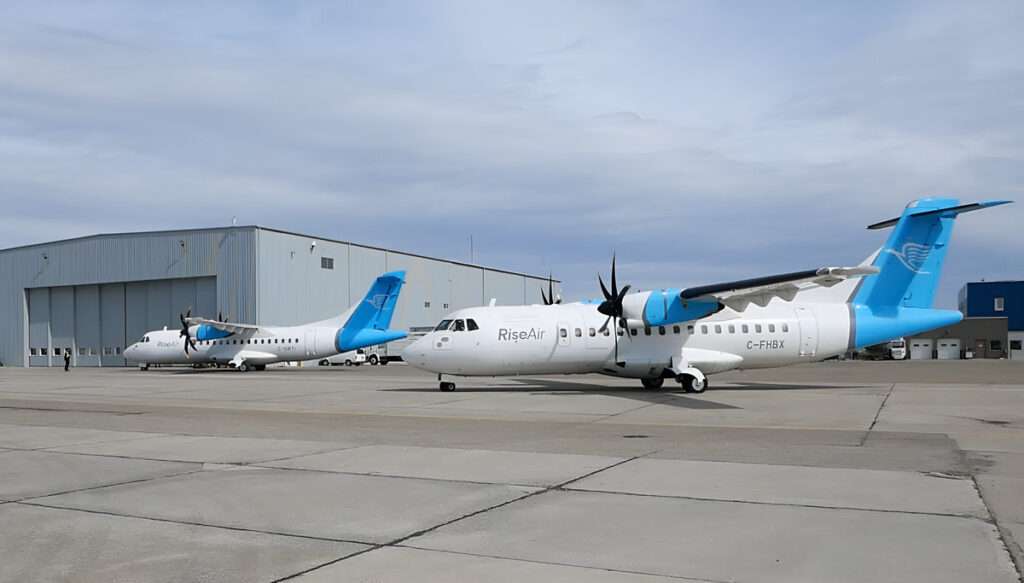Canada’s Rise Air has expanded its operational capabilities with the addition of a second ATR 42-500 aircraft to its fleet.
Registered as C-GRYI, this new plane will primarily serve the airline’s workforce transportation routes, ensuring efficient movement of personnel.
This expansion complements Rise Air’s existing ATR 42-500, registered C-FHBX. The regional commuter aircraft plays a vital role in providing scheduled services across northern Saskatchewan.
ATR42-500 C-GRYI
The arrival of C-GRYI signifies a further step forward for Rise Air. It reinforces its commitment to enhancing service levels throughout the northern Canadian region.
“We are thrilled to welcome this second ATR 42-500 to our Saskatoon hub,” said Derek Nice, President and CEO of Rise Air.
“This addition is a testament to our ongoing efforts to elevate the passenger experience in Saskatchewan’s north. We’re excited to introduce more passengers across our network to the benefits of this quieter, faster aircraft.”
About the ATR 42-500
The ATR 42-500 is a twin-engine turboprop aircraft renowned for its efficiency, reliability, and exceptional performance.
It boasts a comfortable cabin featuring a wider aisle, offering larger overhead storage bins. The model also benefits from superior noise reduction compared to older models.
- Passenger Comfort: Typically configured for 48-50 passengers. The ATR 42-500 boasts a wider aisle and more spacious overhead storage compared to older models. This translates to a more comfortable flying experience for passengers on regional routes. Additionally, improved noise reduction measures contribute to a quieter cabin environment.
- Performance and Efficiency: Renowned for its fuel efficiency. The turboprop-equipped ATR 42-500 keeps operating costs down. This efficiency is a major advantage for airlines, particularly on shorter regional routes. Another performance strength is the aircraft’s short-field capability. The ATR 42-500 can operate from runways as short as 1,000 meters, making it ideal for serving remote communities that may have limited runway infrastructure.
- Operational Advantages: The ATR 42-500’s impressive fuel efficiency and short-field capability combine to give airlines operational flexibility. This allows Rise Air to consider route options that might not be feasible for larger aircraft. The aircraft’s reliability is another operational benefit, ensuring consistent service for passengers.

Rise Air: Committed to Saskatchewan
Rise Air is a 100 per cent Indigenous-owned company. Employing over 280 personnel in locations ranging from Saskatoon to Fond-du-Lac, it serves the north; working and living alongside its valued customers and community partners.
Rise Air’s investment in the ATR 42-500 signifies not only a commitment to its passengers but also a strong belief in the potential of Saskatchewan’s aviation sector and the province’s robust and stable economy.
This move further positions Rise Air to play a key role in the continued growth and development of the region.
The Crucial Role of Regional Aviation in Canada
Canada’s vast geography presents unique challenges for transportation. Major population centers are spread out, and numerous remote communities depend on air travel.
This supports the transfer of essential goods, medical care, and connection to the wider world. This is where regional aviation steps in, serving as a lifeline for countless Canadians.
Regional airlines utilize smaller aircraft, often turboprops like the ATR 42-500 employed by Rise Air, to navigate shorter routes and land at airstrips inaccessible to larger planes.
These services connect smaller towns and cities to regional hubs, and also provide vital links to larger national and international carriers.
The regional aviation market plays a critical role in supporting resource extraction industries like mining and forestry, which are often situated in remote areas.
It also facilitates tourism by enabling access to scenic destinations and national parks.
While the COVID-19 pandemic impacted the entire aviation industry, regional carriers have faced particular struggles.
However, as the industry recovers, regional aviation is expected to see renewed growth, driven by factors like increasing e-commerce and continued development in remote areas.
Rise Air’s investment in its fleet reflects this optimism for the future of regional aviation in Canada.

Click the banner to subscribe to our weekly newsleter.

Click the photo to join our WhatsApp channel so then you can stay up to date with everything going on in the aviation industry!









